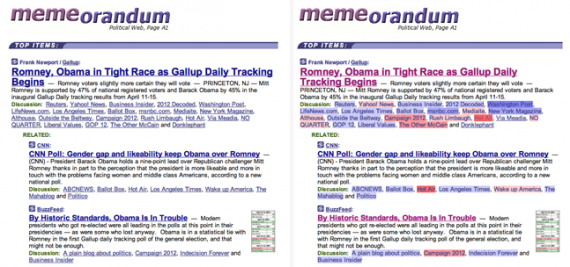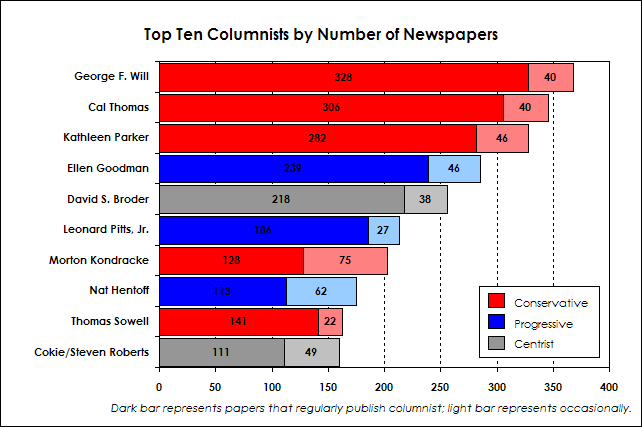Color Coding Blogs by Political Bias
Andy Baio and friends have undertaken an interesting project: color coding political blogs to track bias.
Andy Baio and friends have undertaken an interesting project: color coding political blogs to track bias.
Wired (“Memeorandum Colors 2012: Visualizing Bias on Political Blogs“):
As you’d expect, the universe of political blogs is largely split in two, with conservative and liberal blogs rarely covering the same stories or linking to the same sites. But it can be very challenging to tell their political leanings at a glance, especially with names like “Balloon Juice,” “Weasel Zippers,” or “The Volokh Conspiracy.”
So, four years ago, I launched a project with Delicious/Tasty Labs founder Joshua Schachter to visualize the linking biases of various political blogs on Memeorandum by looking at their past behavior.
Using singular value decomposition, the linear algebra at the heart of your Netflix recommendations, we reduced the entire matrix of blogger-to-article relationships to a single dimension. Imagine a single line grouping like-minded blogs together based on the diversity of the stories they cover, with hardcore left- and right-leaning blogs on opposite sides of the spectrum.
Using those precalculated values, we load the data from Google Spreadsheets and color the links on Memeorandum, based on where they fall on the spectrum. The brighter the color, the more frequently they only cover stories by their counterparts.
So, how’d they do? Well, apparently, OTB is a hard left site:
While some conservatives will see this as confirmation–see, they are a bunch of lefties after all!–it’s rather hard to come up with a definition by which OTB qualifies as liberal. The problem here is that Baio and company have created a self-fulfilling prophecy. They start by assuming that blogs only link to stories that other likeminded people link to and then color code accordingly–thus proving their hypothesis! Instead, rather obviously, they should have come up with the ideological coding independently.
If you’d like to play with this script yourself, the link has downloadable versions for Chrome, Firefox, and Greasemonkey.
UPDATE: It appears that the coding itself is four years old. What’s new here is that they now have four years of data.







I did my master’s thesis on a problem related to principle component analysis using SVD (well, technically I did it on principle component analysis of the eingenvectors of the covariance matrix, but that’s an alternate representation of the same vector space), so I can say that the real problem here is that the producers of this study are completely misrepresenting the mathematics here.
SVD decomposition produces the axes that maximize the spread of the data. Those axes don’t correspond to any particular real world concept. So the assertion that the first axes corresponds to rightness or leftness is an entirely a subjective call by the authors.
If you really want to do this right, you need to start by rating a “example” set of sites on a political bias scale. Then instead of using just one dimension from the SVD, you take several (there’s a formula for calculating how many you should use, but I won’t go into that here), than create a parameterized manifold through the SVD space using your example set. You can then rate the sites by seeing where they fall along that manifold.
This has been around quite a while now James.
@Davebo: Indeed it has. Very odd that it’s in Wired today….
I dont think it’s a bug in the methodology. I think it shows just how far the Republican party has shifted to the right that this place is considered far left.
@Stormy Dragon:
The bonus is that just as thie position on the manifold would tell you rightness or leftness, distrance from the manifold gives you a measure of how strong your model is for that site. If a site is located far away from the manifold, then you know your model probably isn’t a good measure of how right or left that particular site is.
Is this like ATM machine?
If you download the data they have produced, you can see a shift in how their model rates OTB. In May 2010 OTB shifts from being a site on right sometime dipping into the left, to become a site on the left sometime dipping into the right.
May 2010, that was when both Steven Taylor and Doug Mataconis joined the site. I don’t think that’s a coincidence.
Now, I’m not going to argue that either of them is a liberal, but the extra volume from their posts and what they linked to may very well have shifted how his blog is rated.
(The same thing can be seen if you look at the data for LGF, in March 2010, that site went from being on the right and never dipping into the left to being on the left and almost never dipping into the right.)
Indeed. How screwed up does a political movement have to be to lose Charles Johnson?
@Davebo:
He considered himself center-left until 9/11, some years later he looked into the abyss and decided to walk back. Or something…
@PJ:
Problem is that Doug is probably the most reliably partisan of the writers on OTB, so if that’s what caused the shift left, it doesn’t speak well as to the accuracy of the model.
Indeed, it suggest they don’t distinguish whether a particular link is positive or negative, so that something like “Hey, look at what those idiots over at lefty.com are saying now” gets counted as a left leaning link.
@Stormy Dragon:
And that was what I wrote, that the links added by Doug and Steven may have been to what would be considered more left leaning sites. Now the shift may also be due to someone leaving the blog or perhaps not writing as much. For instance, not sure how much Dodd used to participate.
I guess snarky blogs or blogs keeping an eye on the other side may end being up wrongly labeled, but most blogs don’t have a huge percentage of links to other side.
And I also think Gustopher has a point about how lots of blogs on the right have shifted further to the right, which then would mean that more sane sites like OTB don’t link to them as much which moves the in the other direction.
This whole thing is pretty stupid. Seriously Reuters is listed as hard left wing…
@PJ:
I will take some of the blame in the following sense: as I recall when I encountered the plugin that allowed on to see the colors in question, PolIBlog would come out of blueish hue. However, the problem is that does not indicate the content of the posts, but rather sites linked (as noted above).
Part of the problem at the moment is that there aren’t a lot of solid right-leaning sites to link to.
And in regards to Doug: I think it is fair to say that whatever else one might want to say about his leanings, he is hardly the most “liberal” writer on the site.
BTW: evidence that linkage in a post does not tell one a darn thing about its ideological leanings: I just wrote a post in which I linked to three or four “conservative” sites and yet the post itself will clearly be interpreted by many as “liberal” I suspect.
link.